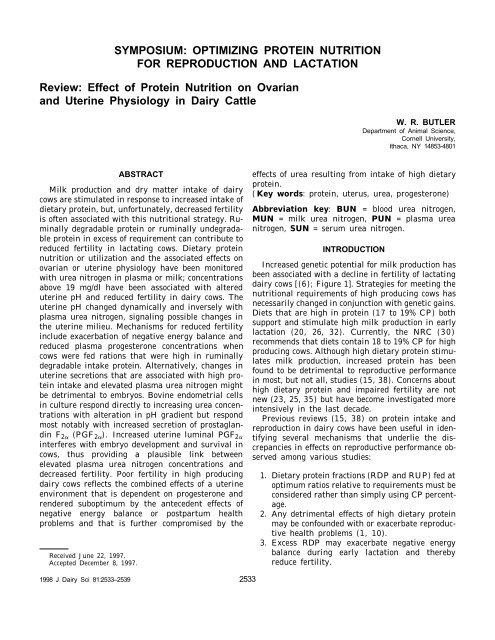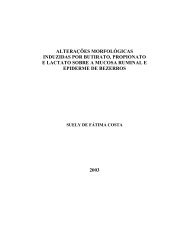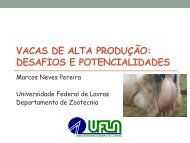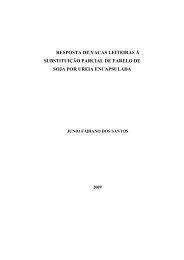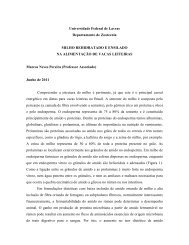SYMPOSIUM: OPTIMIZING PROTEIN NUTRITION ... - Grupo do Leite
SYMPOSIUM: OPTIMIZING PROTEIN NUTRITION ... - Grupo do Leite
SYMPOSIUM: OPTIMIZING PROTEIN NUTRITION ... - Grupo do Leite
Create successful ePaper yourself
Turn your PDF publications into a flip-book with our unique Google optimized e-Paper software.
<strong>SYMPOSIUM</strong>: <strong>OPTIMIZING</strong> <strong>PROTEIN</strong> <strong>NUTRITION</strong><br />
FOR REPRODUCTION AND LACTATION<br />
Review: Effect of Protein Nutrition on Ovarian<br />
and Uterine Physiology in Dairy Cattle<br />
W. R. BUTLER<br />
Department of Animal Science,<br />
Cornell University,<br />
Ithaca, NY 14853-4801<br />
Received June 22, 1997.<br />
Accepted December 8, 1997.<br />
ABSTRACT<br />
Milk production and dry matter intake of dairy<br />
cows are stimulated in response to increased intake of<br />
dietary protein, but, unfortunately, decreased fertility<br />
is often associated with this nutritional strategy. Ruminally<br />
degradable protein or ruminally undegradable<br />
protein in excess of requirement can contribute to<br />
reduced fertility in lactating cows. Dietary protein<br />
nutrition or utilization and the associated effects on<br />
ovarian or uterine physiology have been monitored<br />
with urea nitrogen in plasma or milk; concentrations<br />
above 19 mg/dl have been associated with altered<br />
uterine pH and reduced fertility in dairy cows. The<br />
uterine pH changed dynamically and inversely with<br />
plasma urea nitrogen, signaling possible changes in<br />
the uterine milieu. Mechanisms for reduced fertility<br />
include exacerbation of negative energy balance and<br />
reduced plasma progesterone concentrations when<br />
cows were fed rations that were high in ruminally<br />
degradable intake protein. Alternatively, changes in<br />
uterine secretions that are associated with high protein<br />
intake and elevated plasma urea nitrogen might<br />
be detrimental to embryos. Bovine en<strong>do</strong>metrial cells<br />
in culture respond directly to increasing urea concentrations<br />
with alteration in pH gradient but respond<br />
most notably with increased secretion of prostaglandin<br />
F 2a (PGF 2a ). Increased uterine luminal PGF 2a<br />
interferes with embryo development and survival in<br />
cows, thus providing a plausible link between<br />
elevated plasma urea nitrogen concentrations and<br />
decreased fertility. Poor fertility in high producing<br />
dairy cows reflects the combined effects of a uterine<br />
environment that is dependent on progesterone and<br />
rendered suboptimum by the antecedent effects of<br />
negative energy balance or postpartum health<br />
problems and that is further compromised by the<br />
effects of urea resulting from intake of high dietary<br />
protein.<br />
( Key words: protein, uterus, urea, progesterone)<br />
Abbreviation key: BUN = blood urea nitrogen,<br />
MUN = milk urea nitrogen, PUN = plasma urea<br />
nitrogen, SUN = serum urea nitrogen.<br />
INTRODUCTION<br />
Increased genetic potential for milk production has<br />
been associated with a decline in fertility of lactating<br />
dairy cows [(6); Figure 1]. Strategies for meeting the<br />
nutritional requirements of high producing cows has<br />
necessarily changed in conjunction with genetic gains.<br />
Diets that are high in protein (17 to 19% CP) both<br />
support and stimulate high milk production in early<br />
lactation (20, 26, 32). Currently, the NRC (30)<br />
recommends that diets contain 18 to 19% CP for high<br />
producing cows. Although high dietary protein stimulates<br />
milk production, increased protein has been<br />
found to be detrimental to reproductive performance<br />
in most, but not all, studies (15, 38). Concerns about<br />
high dietary protein and impaired fertility are not<br />
new (23, 25, 35) but have become investigated more<br />
intensively in the last decade.<br />
Previous reviews (15, 38) on protein intake and<br />
reproduction in dairy cows have been useful in identifying<br />
several mechanisms that underlie the discrepancies<br />
in effects on reproductive performance observed<br />
among various studies:<br />
1. Dietary protein fractions (RDP and RUP) fed at<br />
optimum ratios relative to requirements must be<br />
considered rather than simply using CP percentage.<br />
2. Any detrimental effects of high dietary protein<br />
may be confounded with or exacerbate reproductive<br />
health problems (1, 10).<br />
3. Excess RDP may exacerbate negative energy<br />
balance during early lactation and thereby<br />
reduce fertility.<br />
1998 J Dairy Sci 81:2533–2539 2533
2534<br />
BUTLER<br />
Figure 1. The inverse relationship between conception rate<br />
(CR) and annual milk production of Holstein dairy cows in New<br />
York.<br />
Conception and the establishment of pregnancy are<br />
an ordered progression of interrelated events involving<br />
all of the various tissues of the reproductive tract:<br />
follicular development resulting in ovulation, fertilization<br />
of the oocyte, embryo transport and development,<br />
maternal recognition, and implantation.<br />
Hypothetically, ammonia, urea, or some other toxic<br />
product of protein metabolism may intercede at one or<br />
more of these steps to impair reproductive efficiency.<br />
This review focuses on the detrimental effects of high<br />
dietary protein that may be exerted on the physiological<br />
mechanisms of the ovary and uterus.<br />
MONITORING <strong>PROTEIN</strong> METABOLISM<br />
The biological value of protein substrates for the<br />
lactating dairy cow is directly related to the energy<br />
status of the cow and the balance of absorbed amino<br />
acids relative to their requirements. In lactating<br />
cows, dietary protein comprises RDP and RUP fractions.<br />
Through normal ruminal fermentation, RDP<br />
provides a source of ammonia for microbial protein<br />
synthesis. Some of the ammonia that is produced<br />
escapes incorporation by the microorganisms, diffuses<br />
out of the rumen into the portal blood, and is detoxified<br />
in the liver by conversion to urea. The quantity of<br />
ammonia that is produced and the amount that escapes<br />
for conversion to urea directly reflects both<br />
dietary RDP and the availability of fermentable carbohydrates<br />
to support microbial growth and protein<br />
synthesis.<br />
A second source of urea produced by the liver is<br />
from the deamination and metabolism of amino acids.<br />
Circulating amino acids originate from RUP,<br />
microbial protein, and body stores. Amino acids such<br />
as glutamine and arginine are important interorgan<br />
transporters of ammonia nitrogen in a nontoxic form.<br />
These and other available amino acids that are not<br />
taken up for utilization in milk protein synthesis or<br />
deposited elsewhere are deaminated by the liver to<br />
yield energy substrates and urea. As the urea that is<br />
produced by the liver circulates through the blood, it<br />
equilibrates into all tissues, is recycled through the<br />
rumen, and is excreted in urine. Although the production<br />
of ammonia and urea can be minimized by<br />
balancing RDP and RUP, high dietary intake to support<br />
milk production and variation in rumen<br />
microbial protein yield make accurate prediction of<br />
the availability of amino acids very difficult. Consequently,<br />
most high producing cows consume protein<br />
in excess of the requirements, and urea concentrations<br />
are increased in accordance with intake (16).<br />
Urea is the metabolic end product of protein<br />
catabolism in the body and is easily measured by the<br />
nitrogen content (i.e., urea nitrogen concentration).<br />
Urea nitrogen concentrations circulating in the<br />
bloodstream are measured in either plasma or serum<br />
fractions ( PUN or SUN, respectively) and are often<br />
referred to generically as blood urea nitrogen ( BUN).<br />
Typically, BUN peaks about 4 to 6 h after meals<br />
because of RDP catabolism, and the metabolism of<br />
RUP contributes to BUN continuously throughout the<br />
day (13). The fluctuations in BUN during the day are<br />
usually smaller (2 to 3 mg/100 dl) in cows fed a TMR<br />
than in cows fed concentrates and forages separately<br />
(11, 13, 21). Urea is a small, water-soluble molecule<br />
that permeates all cells and tissues in the body and<br />
passes easily between the blood and milk within the<br />
mammary gland (21). With a lag time of less than 1<br />
h for equilibration with blood concentrations, milk<br />
urea nitrogen ( MUN) provides a rapid, noninvasive,<br />
and inexpensive means of assessing the dynamics of<br />
BUN (21, 31) and of monitoring overall protein<br />
metabolism in lactating cows (33). Also, MUN provides<br />
an integrated measure of metabolism and utilization<br />
of RDP and RUP, reflecting both intake and<br />
energy availability (8, 9, 31, 33).<br />
Measurements of BUN or MUN have provided a<br />
useful index for studying the association between<br />
metabolism of dietary protein and reproductive efficiency.<br />
Conception rate decreased when SUN concentrations<br />
exceeded 20 mg/dl on the day of insemination,<br />
suggesting that degradation of excessive<br />
amounts of dietary protein in the rumen contributed<br />
to infertility (14). A more detailed field trial (16)<br />
with nine commercial dairy herds confirmed the inverse<br />
relationship of high SUN on conception rate and<br />
emphasized the detrimental effects of fertility when<br />
SUN exceeded 20 mg/dl. More recently, both PUN<br />
Journal of Dairy Science Vol. 81, No. 9, 1998
<strong>SYMPOSIUM</strong>: <strong>OPTIMIZING</strong> <strong>PROTEIN</strong> <strong>NUTRITION</strong> FOR REPRODUCTION AND LACTATION 2535<br />
TABLE 1. High dietary CP and postpartum ovarian activity in<br />
dairy cows.<br />
Effect on days<br />
CP<br />
to first estrus<br />
in diet or ovulation Reference<br />
(%)<br />
20 1 Delay of 13 d (38)<br />
20 2 Delay of 4 d ( 1 )<br />
19 NS (7)<br />
19.3 Reduced 9 d (23)<br />
19.4 NS (25)<br />
20 NS (10)<br />
1Excessive RDP (72.5% of CP).<br />
2Effect of reproductive health status included.<br />
and MUN concentrations were used to monitor pregnancy<br />
rate, and the range of urea nitrogen concentrations<br />
in high producing cows and the inverse relationship<br />
between PUN (>19 mg/dl) and fertility were<br />
both confirmed (5). Most reports (38) have found<br />
that elevated BUN concentrations are associated with<br />
some deficiency in the reproductive performance of<br />
cows.<br />
OVARIAN CYCLES AND CIRCULATING<br />
PROGESTERONE CONCENTRATIONS<br />
The intake of high CP diets by lactating cows<br />
following parturition has had inconsistent effects on<br />
the reinitiation of ovarian activity (Table 1). Diets<br />
containing 20% CP prolonged the interval of days to<br />
first ovulation when RDP was particularly in excess<br />
[72.5% of CP; (38)] or when reproductive health status<br />
was included in the statistical assessment (1).<br />
Others (7, 10, 23, 25), however, have reported that<br />
diets with 19 to 21% CP did not delay the postpartum<br />
interval to first ovulation or estrus. Follicular development<br />
in nonlactating cows was not perturbed by<br />
high CP diets (18), but, thus far, no effects during<br />
the development of ovarian follicles in postpartum<br />
lactating cows has been reported. Overall, high CP in<br />
the diet <strong>do</strong>es not appear to have a strong impact on<br />
the reinitiation of ovarian activity in the postpartum<br />
period.<br />
Jordan and Swanson (24) were the first to report<br />
that cows fed low CP (12.7%) during the breeding<br />
period had higher serum progesterone concentrations<br />
than did cows fed 16.3 or 19.3% CP. In other studies,<br />
progesterone concentrations in circulation were lower<br />
(36, 38) or were not affected (1, 18) in dairy cows fed<br />
high protein diets (Table 2). One explanation for<br />
these conflicting responses is the difference in the<br />
lactational status of the cows in the various studies.<br />
High dietary CP reduced plasma progesterone concentrations<br />
in lactating cows in three of four studies (4,<br />
24, 36, 38), but did not reduce concentrations in<br />
nonlactating cows (4, 18) or heifers (12). Plasma<br />
progesterone concentrations progressively increase<br />
over the first three ovarian cycles during early lactation,<br />
and the rate of increase is reduced or moderated<br />
by the effects of negative energy balance (37, 39).<br />
When cows are fed excess RDP during early lactation,<br />
the negative energy balance is exacerbated because of<br />
the energy cost of detoxifying ammonia escaping from<br />
the rumen (38), but changes in metabolic clearance<br />
rate of progesterone should also be considered. Therefore,<br />
the deleterious effects of a negative energy<br />
balance that is more extreme might explain the lower<br />
plasma progesterone concentrations that were observed<br />
in studies with postpartum cows fed high CP<br />
(24, 36, 38). Reduced concentrations of plasma<br />
progesterone during the early breeding period appears<br />
to be a likely component of the reduction in<br />
fertility associated with feeding high dietary protein.<br />
EMBRYO DEVELOPMENT<br />
The effects of high protein intake on early embryo<br />
development have been studied in dairy cows. Early<br />
degeneration and poor development of embryos occurred<br />
in lactating cows that were fed excess RDP<br />
(3), but a similar, well-controlled study of nonlactating<br />
cows found that excess intake of CP failed to<br />
affect the health and number of embryos (18). Because<br />
the energy status of the cows preceding each of<br />
these studies was markedly different, depending on<br />
whether or not they were lactating, those researchers<br />
(18) suggested that the consequence of increasing<br />
TABLE 2. High dietary CP and plasma progesterone concentrations<br />
(PPC) during the estrous cycle of lactating and nonlactating dairy<br />
cows.<br />
CP<br />
Effects<br />
in diet on PPC Lactating Reference<br />
(%)<br />
19.3 Reduced 25% 1 Yes (24)<br />
20 Reduced 30% 1 Yes (36)<br />
20 2 Reduced 50% Yes (38)<br />
20 NS 3 Yes ( 1 )<br />
27.4 NS No (18)<br />
25 NS No (4)<br />
21.8 4 NS No (12)<br />
1During more than one estrous cycle.<br />
2Excessive RDP (72.5% of CP).<br />
3Nonsignificant ( P > 0.05).<br />
4Heifers >14 mo of age fed diet containing 70% ME required.<br />
Journal of Dairy Science Vol. 81, No. 9, 1998
2536<br />
BUTLER<br />
dietary CP content or degradability in lactating cows<br />
might be to exacerbate one or more factors affecting<br />
nutrition, metabolism, or energy balance that would<br />
result in lower reproductive performance (i.e., impaired<br />
embryo development). Indeed, increased embryo<br />
losses were reported for heifers that were fed an<br />
energy-restricted diet containing high amounts of<br />
degradable protein (12). Furthermore, negative<br />
energy balance during the early postpartum period<br />
might exert residual effects during the 40 to 60 d<br />
required for follicular development that might impair<br />
the health of preovulatory follicles later during the<br />
breeding period (27). Therefore, the combined effects<br />
of excess RDP and energy status might explain why<br />
the embryo quality of lactating cows was compromised<br />
(3).<br />
A recent study with sheep supports the detrimental<br />
effects of high RDP on embryo development. Bishonga<br />
et al. ( 2 ) suggested that elevated circulating concentrations<br />
of urea and ammonia resulting from feeding<br />
high RDP exerted an adverse effect on early embryo<br />
development (d 4 to 11). However, because their<br />
study of dietary treatments followed by insemination<br />
were conducted within 30 d after termination of lactation,<br />
the effects attributed to high RDP might be<br />
confounded with the possible residual effects of antecedent<br />
energy status of the ewes during lactation<br />
(e.g., negative energy balance).<br />
Given the results of studies of dairy cows involving<br />
embryo collection and evaluation, no evidence exists<br />
that high dietary protein has an impact on ovarian<br />
follicular development, ovulation, or fertilization of<br />
oocytes (3, 18). However, there is an interaction between<br />
the effects of CP and energy status during<br />
lactation that may impair embryo development. The<br />
relative significance of the separate effects and their<br />
interactions are not yet fully resolved.<br />
UTERINE PHYSIOLOGY<br />
Successful development of the embryo during early<br />
pregnancy depends upon the nature of the uterine<br />
luminal environment (29). The luminal environment<br />
is dynamic and exhibits marked differences between<br />
the stages of the estrous cycle, and further evolution<br />
occurs during early pregnancy in support of the developing<br />
embryo. The cyclic nature of the microenvironment<br />
of the lumen is a consequence of ovarian<br />
steroidal regulation of en<strong>do</strong>metrial secretion (17, 29).<br />
The local signaling effects of secretions from the<br />
blastocyst further modify the milieu and induce the<br />
secretion of specific proteins by the uterine<br />
epithelium (29). Early embryonic mortality (by d 7<br />
of pregnancy) in lactating dairy cows has been found<br />
(40) to be associated with concentrations of ions and<br />
protein in the uterine environment that were significantly<br />
( P < 0.05) different from those in cows with<br />
normal embryos.<br />
Jordan et al. (22) examined the effects of dietary<br />
CP on the constituents of uterine secretions at various<br />
stages of the estrous cycle in high producing dairy<br />
cows. Blood ammonia and urea concentrations and<br />
urea in uterine secretion were all higher for cows fed<br />
23% CP than for cows fed 12% CP. Intake by cows of<br />
23% CP altered the concentrations of magnesium,<br />
potassium, and phosphorus in uterine secretions, but<br />
only during the luteal phase and not at estrus.<br />
Differential effects during the estrous cycle of high CP<br />
on the uterine environment were also observed for<br />
uterine luminal pH (12, 13). Uterine pH normally<br />
increases from about 6.8 at estrus to 7.1 on d 7 of the<br />
estrous cycle, but this increase failed to occur in both<br />
heifers and lactating cows fed excess RDP or RUP<br />
(12, 13). Uterine pH was inversely related to PUN,<br />
regardless of diet (13). The combined results from<br />
those studies suggest that high dietary CP may<br />
reduce fertility by interfering with the normal induc-<br />
TABLE 3. Changes in plasma urea nitrogen (PUN) and ammonia concentrations following feeding in<br />
dairy cows.<br />
0h 4h 8h<br />
Cow Ammonia PUN Ammonia PUN Ammonia PUN<br />
( mg/dl) (mg/dl) ( mg/dl) (mg/dl) ( mg/dl) (mg/dl)<br />
4783 42 24 33 25 12 25<br />
4788 76 20.5 82 22 24 21<br />
4890 76 20 115 22.5 39 23<br />
5292 21 24 21 26 1 26<br />
5311 15 28 9 28.5 1 28<br />
5331 36 23 24 25.5 1 22<br />
5339 145 23 27 25.5 1 23<br />
5345 12 21.5 1 21.5 1 20<br />
5359 70 26 49 28 3 27<br />
X 55.0 23.3 40.0 24.9 9.2 23.9<br />
Journal of Dairy Science Vol. 81, No. 9, 1998
<strong>SYMPOSIUM</strong>: <strong>OPTIMIZING</strong> <strong>PROTEIN</strong> <strong>NUTRITION</strong> FOR REPRODUCTION AND LACTATION 2537<br />
Figure 2. The concurrent measurements and correlation of<br />
plasma urea nitrogen (PUN) and uterine luminal pH in lactating<br />
dairy cows (n = 8) sampled during 36 h. For the regression<br />
equation, R 2 = 0.22.<br />
tive effects of progesterone on the microenvironment<br />
of the uterus, thereby providing suboptimal conditions<br />
for the support of embryo development.<br />
LINKAGES BETWEEN <strong>PROTEIN</strong> METABOLISM<br />
AND THE UTERINE ENVIRONMENT<br />
The intake of high dietary CP results in elevated<br />
blood concentrations of ammonia and urea. Conceivably,<br />
one or both of these metabolites is responsible for<br />
altering the luminal microenvironment of the uterus.<br />
When diets with 22 to 27% CP were fed, the ammonia<br />
in blood was increased by 25 to 50% (18, 22) or not at<br />
all (12). In the latter study, blood ammonia was low<br />
even though the animals were fed an energyrestricted<br />
diet. From recent measurements in cows<br />
fed a 19% CP TMR, plasma ammonia concentrations<br />
were low (Table 3) and unrelated to elevated PUN<br />
concentrations, which peaked 4 to 8 h after feeding<br />
(11, 13). Because accurate measurements of blood<br />
ammonia require special procedures and rapid analysis<br />
(12), differences in metho<strong>do</strong>logy may account for<br />
the discrepancies in ammonia values among the<br />
studies. It remains uncertain whether blood ammonia<br />
concentrations in lactating cows are sufficient to affect<br />
fertility. Furthermore, ammonia would be<br />
directly involved only when RDP, not RUP, was in<br />
excess.<br />
Across the literature, an excess amount of either<br />
RDP or RUP results in lower fertility; consideration of<br />
protein fractions, rather than CP, explained much of<br />
the variation in conception rate that was observed<br />
among the studies (15). Because RDP and RUP are<br />
metabolized and utilized separately and by different<br />
organs in the lactating cow, the common element of<br />
their metabolism when in excess of requirement is the<br />
formation of urea. Excess of either RDP or RUP increased<br />
PUN and altered uterine pH to a similar<br />
degree (13). Those observations further support the<br />
potential for urea as the common mediator of uterine<br />
effects of excess RDP or RUP. In addition, PUN varies<br />
inversely with uterine pH (13) and, thereby, is a<br />
possible mediator of decreased fertility associated<br />
with elevated PUN or MUN (5).<br />
The active involvement of urea in uterine physiology<br />
is being investigated in further studies (W. R.<br />
Butler and R. O. Gilbert, unpublished). Lactating<br />
cows (n = 8) were fitted with intrauterine Foley<br />
catheters (12) to allow the frequent monitoring of<br />
uterine pH in association with PUN concentrations.<br />
Cows were fed a TMR containing 18% CP with RDP<br />
and RUP balanced for requirements (30). Uterine pH<br />
and PUN concentrations across cows during 36 h of<br />
observation were correlated (Figure 2). The sequential<br />
measurement of PUN and uterine pH demonstrated<br />
that uterine pH is quite dynamically attuned<br />
to changes in PUN, given a time lag of several hours<br />
(Figures 3 and 4). These results strongly suggest<br />
that PUN concentrations throughout the range of 12<br />
to 24 mg/dl can exert direct effects on uterine function.<br />
A system of en<strong>do</strong>metrial cell culture has been developed<br />
to study the effects of urea on secretory function<br />
(19). In this three-dimensional system, the en<strong>do</strong>metrial<br />
cells become polarized and establish a pH<br />
Figure 3. The time course of inverse changes in plasma urea<br />
nitrogen (PUN) and uterine luminal pH in a lactating cow (cow<br />
5919). Feeding occurred at the times indicated by arrows during<br />
the 38-h period of study.<br />
Journal of Dairy Science Vol. 81, No. 9, 1998
2538<br />
BUTLER<br />
Figure 4. The time course of inverse changes in plasma urea<br />
nitrogen (PUN) and uterine luminal pH in a lactating cow (cow<br />
5776). Feeding occurred at the times indicated by arrows during<br />
the 40-h period of study.<br />
gradient between apical and basal compartments as<br />
soon as the cells reach confluence. The pH gradient is<br />
sensitive to both estradiol and progesterone. The<br />
presence of urea significantly ( P < 0.05) diminished<br />
the effects of progesterone in maintaining a pH<br />
differential between apical and basal compartments.<br />
Large amounts of PGF 2a and PGE 2 are secreted by<br />
the en<strong>do</strong>metrial cultures. Treatment of the cultures<br />
with both estradiol and progesterone suppressed PGF<br />
production, but the presence of urea significantly ( P <<br />
0.01) increased the secretion of PGF 2a and PGE 2 .<br />
The importance of further studies on the effects of<br />
urea on the production of en<strong>do</strong>metrial prostaglandin<br />
stems from the evidence that PGF 2a interferes with<br />
embryo development (28) and viability (34).<br />
CONCLUSIONS<br />
To support and stimulate high milk production,<br />
dairy cows are usually fed diets that are high in<br />
protein (>17% CP), which appears to result in<br />
decreased reproductive performance. Investigations of<br />
this inverse relationship have indicated that excesses<br />
of either RDP or RUP relative to requirements result<br />
in lower fertility and that high amounts of dietary<br />
protein exacerbate the effects of negative energy<br />
balance and reproductive health problems to impair<br />
reproduction further. Because the metabolism of excess<br />
RDP or RUP results in high urea production,<br />
monitoring of BUN or MUN concentrations has<br />
proved to be useful in associating decreased conception<br />
rate with BUN or MUN concentrations above 19<br />
to 20 mg/dl. As part of the progression of events<br />
involved in establishing pregnancy, high dietary RDP<br />
seems not to impact follicle development or ovulation,<br />
but results in reduced concentrations of plasma<br />
progesterone in lactating cows, which appears to be<br />
linked to the effects of exacerbated negative energy<br />
balance. The effects of RDP on energy status may also<br />
impair embryo development. Embryo survival and<br />
growth depend upon the quality of the uterine luminal<br />
environment, and the intake of high dietary protein<br />
alters uterine secretions. Blood urea concentrations,<br />
rather than ammonia, seems to be related to<br />
the detrimental effects on fertility as shown by the<br />
dynamic changes in uterine pH with PUN and in<br />
vitro evidence that urea alters pH and prostaglandin<br />
production in en<strong>do</strong>metrial cell cultures. In conclusion,<br />
the poor fertility of high producing dairy cows reflects<br />
the combined effects of a uterine environment that is<br />
dependent on progesterone, but has been rendered<br />
suboptimal by antecedent effects of negative energy<br />
balance or postpartum health problems and has been<br />
further compromised by the effects of urea resulting<br />
from intake of high dietary protein.<br />
REFERENCES<br />
1 Barton, B. A., H. A. Rosario, G. W. Anderson, B. P. Grindle, and<br />
D. J. Carroll. 1996. Effects of dietary crude protein, breed,<br />
parity, and health status on the fertility of dairy cows. J. Dairy<br />
Sci. 79:2225–2236.<br />
2 Bishonga, C., J. J. Robinson, T. G. McEvoy, P. Findlay, R. P.<br />
Aiten, and I. Robertson. 1996. Excess dietary urea intake in<br />
ewes and its effect on ovulation rate and embryo development.<br />
Jpn. J. Vet. Res. 44:139–151.<br />
3 Blanchard, T., J. D. Ferguson, L. Love, T. Takeda, B. Henderson,<br />
J. Hasler, and W. Chalupa. 1990. Effect of dietary crude<br />
protein type on fertilization and embryo quality in dairy cattle.<br />
Am. J. Vet. Res. 51:905–908.<br />
4 Blauwiekel, R., R. L. Kincaid, and J. J. Reeves. 1986. Effect of<br />
high crude protein on pituitary and ovarian function in Holstein<br />
cows. J. Dairy Sci. 69:439–446.<br />
5 Butler, W. R., J. J. Calaman, and S. W. Beam. 1996. Plasma<br />
and milk urea nitrogen in relation to pregnancy rate in lactating<br />
dairy cattle. J. Anim. Sci. 74:858–865.<br />
6 Butler, W. R., and R. D. Smith. 1989. Interrelationships between<br />
energy balance on postpartum reproductive function in<br />
dairy cattle. J. Dairy Sci. 72:767–783.<br />
7 Canfield, R. W., C. J. Sniffen, and W. R. Butler. 1990. Effects of<br />
excess degradable protein on postpartum reproduction and<br />
energy balance in dairy cattle. J. Dairy Sci. 73:2342–2349.<br />
8 Carlsson, J. 1989. Milk urea as a marker of nutritional imbalance<br />
in dairy cows with special reference to fertility. Pages<br />
396–401 in Proc. 8th Int. Conf. Prod. Dis. F. A. Kallfelz, Publ.<br />
Coll. Vet. Med., Cornell Univ., Ithaca, NY.<br />
9 Carlsson, J., and B. Pehrson. 1994. The influence of the dietary<br />
balance between energy and protein on milk urea concentration.<br />
Experimental trials assessed by two different protein<br />
evaluation systems. Acta Vet. Scand. 35:193–205.<br />
10 Carroll, D. J., B. A. Barton, G. W. Anderson, and R. D. Smith.<br />
1988. Influence of protein intake and feeding strategy on<br />
reproductive peformance of dairy cows. J. Dairy Sci. 71:<br />
3470–3481.<br />
11 Ciszuk, P., E. Sporndly, T. Gebregziabher, and R. Oltner. 1997.<br />
Diurnal variation in urea content of blood, milk and urine in<br />
Journal of Dairy Science Vol. 81, No. 9, 1998
<strong>SYMPOSIUM</strong>: <strong>OPTIMIZING</strong> <strong>PROTEIN</strong> <strong>NUTRITION</strong> FOR REPRODUCTION AND LACTATION 2539<br />
lactating cows and goats. Rep. 224, Sveriges Lantbruksuniv.,<br />
Uppsala, Sweden.<br />
12 Elrod, C. C., and W. R. Butler. 1993. Reduction of fertility and<br />
alteration of uterine pH in heifers fed excess ruminally degradable<br />
protein. J. Anim. Sci. 71:694–701.<br />
13 Elrod, C. C., M. Van Amburgh, and W. R. Butler. 1993. Alterations<br />
of pH in response to increased dietary protein in cattle are<br />
unique to the uterus. J. Anim. Sci. 71:702–706.<br />
14 Ferguson, J. D., T. Blanchard, D. T. Galligan, D. C. Hoshall,<br />
and W. Chalupa. 1988. Infertility in dairy cattle fed a high<br />
percentage of protein degradable in the rumen. JAVMA 192:<br />
659–662.<br />
15 Ferguson, J. D., and W. Chalupa. 1989. Impact of protein<br />
nutrition on reproduction in dairy cows. J. Dairy Sci. 72:<br />
746–766.<br />
16 Ferguson, J. D., D. T. Galligan, T. Blanchard, and M. Reeves.<br />
1993. Serum urea nitrogen and conception rate: the usefulness<br />
of test information. J. Dairy Sci. 76:3742–3746.<br />
17 Findlay, P., L. A. Salamonsen, and R. A. Cherney. 1990. En<strong>do</strong>metrial<br />
function: studies using isolated cells in vitro. Oxford<br />
Rev. Reprod. Biol. 12:181–223.<br />
18 Garcia-Bojalil, C. M., C. R. Staples, W. W. Thatcher, and<br />
M. Drost. 1994. Protein intake and development of ovarian<br />
follicles and embryos of superovulated nonlactating dairy cows.<br />
J. Dairy Sci. 77:2537–2548.<br />
19 Gilbert, R. O., S. T. Shin, T. S. Rabuffo, and S. K. Chandler.<br />
1996. An in vitro model for the study of bovine en<strong>do</strong>metrial<br />
physiology and pathophysiology. Page II–1 in Proc. 13th Int.<br />
Congr. Anim. Reprod., Sydney, Australia.<br />
20 Grings, E. E., R. E. Roffler, and D. P. Deitelhoff. 1991. Response<br />
of dairy cows in early lactation to additions of cottonseed meal<br />
in alfalfa-based diets. J. Dairy Sci. 74:2580–2587.<br />
21 Gustafsson, A. H., and D. L. Palmquist. 1993. Diurnal variation<br />
of rumen ammonia, serum urea, and milk urea in dairy cows at<br />
high and low yields. J. Dairy Sci. 76:475–484.<br />
22 Jordan, E. R., T. E. Chapman, D. W. Holtan, and L. V. Swanson.<br />
1983. Relationship of dietary crude protein to composition<br />
of uterine secretions and blood in high-producing dairy cows. J.<br />
Dairy Sci. 66:1854–1862.<br />
23 Jordan, E. R., and L. V. Swanson. 1979. Effect of crude protein<br />
on reproductive efficiency, serum total protein and albumin in<br />
the high-producing dairy cow. J. Dairy Sci. 62:58–63.<br />
24 Jordan, E. R., and L. V. Swanson. 1979. Serum progesterone<br />
and luteinizing hormone in dairy cattle fed varying levels of<br />
crude protein. J. Anim. Sci. 48:1154–1158.<br />
25 Kaim, M., Y. Folman, H. Neumark, and W. Kaufmann. 1983.<br />
The effect of protein intake and lactation number on postpartum<br />
body weight loss and reproductive performance of dairy<br />
cows. Anim. Prod. 37:229–235.<br />
26 Kung Jr., L., and J. T. Huber. 1983. Performance of high<br />
producing cows in early lactation fed protein of varying<br />
amounts, sources and degradability. J. Dairy Sci. 66:227–234.<br />
27 Lucy, M. C., W. W. Thatcher, and C. R. Staples. 1992. Postpartum<br />
function: nutritional and physiological interactions. Pages<br />
135–145 in Large Dairy Herd Management. H. H. Van Horn<br />
and C. J. Wilcox, ed. ADSA, Champaign, IL.<br />
28 Mauer, R. R., and H. M. Beier. 1976. Uterine proteins and<br />
development in vitro of rabbit preimplantation embryos. J.<br />
Reprod. Fertil. 48:33–41.<br />
29 McRae, A. C. 1984. The blood-uterine lumen barrier and its<br />
possible significance in early embryo development. Oxford Rev.<br />
Reprod. Biol. 6:129–173.<br />
30 National Research Council. 1989. Nutrient Requirements of<br />
Dairy Cattle. 6th rev. ed. Washington, DC. Natl. Acad. Sci.,<br />
Washington, DC.<br />
31 Oltner, R., and H. Wiktorsson. 1983. Urea concentrations in<br />
milk and blood as influenced by feeding varying amounts of<br />
protein and energy to dairy cows. Livest. Prod. Sci. 10:457–467.<br />
32 Roffler, R. E., and D. L. Thacker. 1983. Influence of reducing<br />
dietary crude protein from 17 to 13.5% on early lactation. J.<br />
Dairy Sci. 66:51–58.<br />
33 Roseler, D. K., J. D. Ferguson, C. J. Sniffen, and J. Herrema.<br />
1993. Dietary protein degradability effects on plasma and milk<br />
urea nitrogen and milk nonprotein nitrogen in Holstein cows. J.<br />
Dairy Sci. 76:525–534.<br />
34 Schrick, F. N., E. K. Inskeep, and R. L. Butcher. 1993. Pregnancy<br />
rates for embryos transferred from early postpartum beef<br />
cows into recipients with normal estrous cycles. Biol. Reprod.<br />
49:617–621.<br />
35 Sonderegger, H., and A. Schurch. 1977. A study of the influence<br />
of the energy and protein supply on the fertility of dairy cows.<br />
Livest. Prod. Sci. 4:327–333.<br />
36 Sonderman, J. P., and L. L. Larson. 1989. Effect of dietary<br />
protein and exogenous gona<strong>do</strong>tropin-releasing hormone on circulating<br />
progesterone concentrations and performance of Holstein<br />
cows. J. Dairy Sci. 72:2179–2183.<br />
37 Spicer, L. J., W. B. Tucker, and G. D. Adams. 1990. Insulin-like<br />
growth factor-I in dairy cows: relationships among energy<br />
balance, body condition, ovarian activity, and estrous behavior.<br />
J. Dairy Sci. 73:929–937.<br />
38 Staples, C. R., C. M. Garcia-Bojalil, B. S. Oldick, W. W.<br />
Thatcher, and C. A. Risco. 1993. Protein intake and reproductive<br />
performance of dairy cows: a review, a suggested mechanism,<br />
and blood and milk urea measurements. Pages 37–51 in<br />
Proc. 4th Annu. Florida Ruminant Nutr. Symp., Univ. Florida,<br />
Gainesville.<br />
39 Villa-Go<strong>do</strong>y, A., T. L. Hughes, R. S. Emery, L. T. Chapin, and<br />
R. L. Fogwell. 1988. Association between energy balance and luteal<br />
function in lactating dairy cows. J. Dairy Sci. 71:<br />
1063–1072.<br />
40 Wiebold, J. L. 1988. Embryonic mortality and the uterine environment<br />
in first-service lactating dairy cows. J. Reprod. Fertil.<br />
84:393–399.<br />
Journal of Dairy Science Vol. 81, No. 9, 1998


